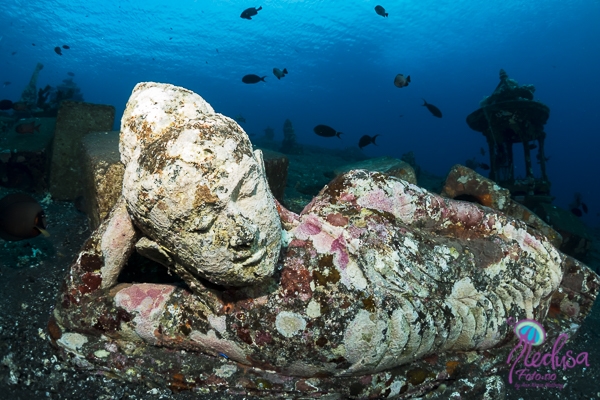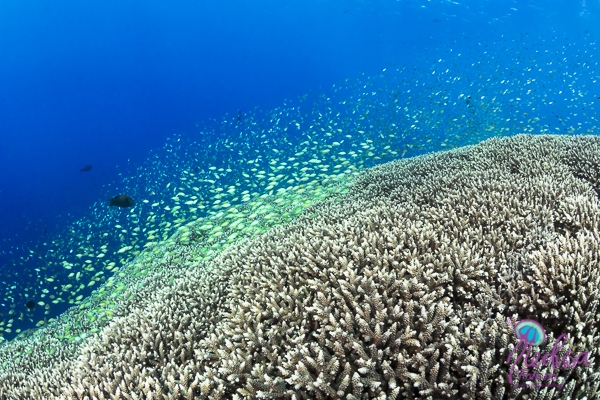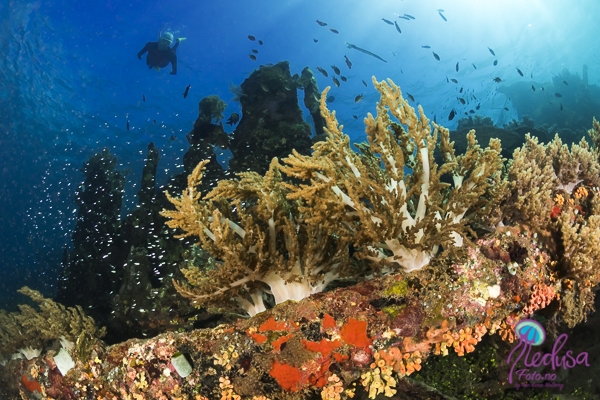In the southern part of Amed, just across the road from BaliKu Dive Resort, lays another gem. “The Japanese shipwreck” is laying on the housereef, equally accessible as Liberty, and even shallower. This is a small wreck, and divers go there for two main reasons – the diversity of nudibranch and small stuff you find on and around the wreck, and the incredibly healthy corals that stretch out on the left side of the beach. This is probably one of the best preserved collections of hard corals in this part of Bali! Because of the good condition this reef is in, sharks patrol the area on regular basis, but the amount of small fish living by the reef is just astonishing. They form huge schools, and just watching them move in and out of the corals is like therapy – constantly changing patterns like a flock of birds getting ready to migrate.
So here you get everything: Wreck, corals and small stuff. But there is a drawback. The current can be very strong here at times, depending on the tides, so plan your dive carefully with people who know the area. It is a very simple dive at the right times, superb even for beginners. At the wrong time, you shouldn’t dive here.

Ann Karin Matberg • OM-D E-M1 • M.ZUIKO DIGITAL ED 8mm 1:1.8 Fisheye
• PT-EP11 • PPO-EP02 • 2 x UFL-3
These were just two examples of all the great diving spots Bali has to offer, since Bali has such a huge number of great dive sites. If you’re looking for more action, more big stuff, you might want to check out the southern part of Bali, even though sharks, rays, barracudas and dolphins are regularly seen all over the island. But Nusa Penida, an island on the south east side of Bali, is famous for this. Water is usually colder here than in the north. Between September and November, when the water is coldest, you can even get a chance to dive with the strange looking sunfish, the Mola Mola. But be prepared – they like chilly water, and an extra wet suit and a hood is needed. Descending from the comfortable warmth of 24-25 degrees at the surface and going through the thermocline and suddenly finding yourself in 16-18 degrees of water is a bit of a shock, but absolutely worth it when the odd looking fish is suddenly in front of you.
We also have to briefly mention the Menjangan island on the far north west part of Bali. Here you get absolutely stunning wall diving where the steep walls stretch above and below you, in front of and behind you.

Ann Karin Matberg • OM-D E-M1 • M.ZUIKO DIGITAL ED 8mm 1:1.8 Fisheye
• PT-EP11 • PPO-EP02 • 2 x UFL-3
You can dive all around Bali, and every spot has something nice and surprising to show you. Schools of colorful fish, sharks patrolling the reef, turtles feeding or huge murrays getting their mouth cleaned. Or what do you say to an underwater temple on the house reef of Matahari dive center in Tulamben? Complete with goddesses and guardians - a truly spectacular and different dive site.

Ann Karin Matberg • OM-D E-M1 • M.ZUIKO DIGITAL ED 8mm 1:1.8 Fisheye
• PT-EP11 • PPO-EP02 • 2 x UFL-3
And yet we have not even started talking about the extremely fascinating macro world you can get to know here. In my next blog article we’ll stay in Bali, but plunge into the colorful and fascinating world of nudibranchs.
The video below is a little introduction to what we will be covering next time. See you then!
Comments
superbe photo !!!!
Show more comments (5)